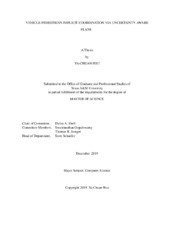| dc.contributor.advisor | Shell, Dylan | |
| dc.creator | Hsu, Ya-Chuan | |
| dc.date.accessioned | 2020-08-26T16:53:33Z | |
| dc.date.available | 2020-08-26T16:53:33Z | |
| dc.date.created | 2019-12 | |
| dc.date.issued | 2019-11-15 | |
| dc.date.submitted | December 2019 | |
| dc.identifier.uri | https://hdl.handle.net/1969.1/188747 | |
| dc.description.abstract | Drivers and other road users often encounter situations where priority is unclear or ambiguous, but must be resolved, for example, after arriving at an intersection nearly simultaneously. The participants in such scenarios reach agreement by communicating; while instinctive to humans, this is a significant challenge for autonomous vehicles. Currently, the nature of interaction for resolving ambiguous road situations between pedestrians and autonomous vehicles remains mostly in the realm of speculation, for which no direct means for expressing intent and acknowledgment has yet been established. This thesis approaches the challenge by contributing a model and approach for planning that can produce actions that are expressive and encode certain aspects of intent; the result is communicative in that vehicle-pedestrian coordination arises via a negotiation of intent in a prototypical unsignalized intersection crossing scenario. We deliberately construct a prototypical crossing setting with a vehicle and one pedestrian at an unsignalized intersection such that there is substantial ambiguity in crossing order. A decision-theoretic model is then used for capturing this scenario along with its ambiguity as uncertainty arising from non-determinism and partial observability. We solve the problem by first proposing a Markov decision process to express the interaction at the intersection.
Next, we focus on the partial-observability and include it in the model to generate a sequence of vehicle actions by solving via a state-of-the-art online solver. We implement the approach on a self-driving Ford Lincoln MKZ platform and examine an experimental setting involving real-time interaction. The experiment shows that the method achieves safe and efficient navigation. We analyze the resulting policy in detail in simulation and examine the coupled behavior of the vehicle and pedestrian, interpreting evidence for implicit communication that emerges as the two resolve ambiguity to achieve safe and efficient navigation. | en |
| dc.format.mimetype | application/pdf | |
| dc.language.iso | en | |
| dc.subject | Uncertainty-Aware Plans | en |
| dc.subject | Vehicle-Pedestrian Interaction | en |
| dc.subject | Partially Observable Markov Decision Process | en |
| dc.subject | Autonomous Vehicle | en |
| dc.subject | Social Human-Robot Interaction | en |
| dc.title | Vehicle-Pedestrian Implicit Coordination via Uncertainty-Aware Plans | en |
| dc.type | Thesis | en |
| thesis.degree.department | Computer Science and Engineering | en |
| thesis.degree.discipline | Computer Science | en |
| thesis.degree.grantor | Texas A&M University | en |
| thesis.degree.name | Master of Science | en |
| thesis.degree.level | Masters | en |
| dc.contributor.committeeMember | Gopalswamy, Swaminathan | |
| dc.contributor.committeeMember | Ioerger, Thomas | |
| dc.type.material | text | en |
| dc.date.updated | 2020-08-26T16:53:33Z | |
| local.etdauthor.orcid | 0000-0003-0257-7746 | |


